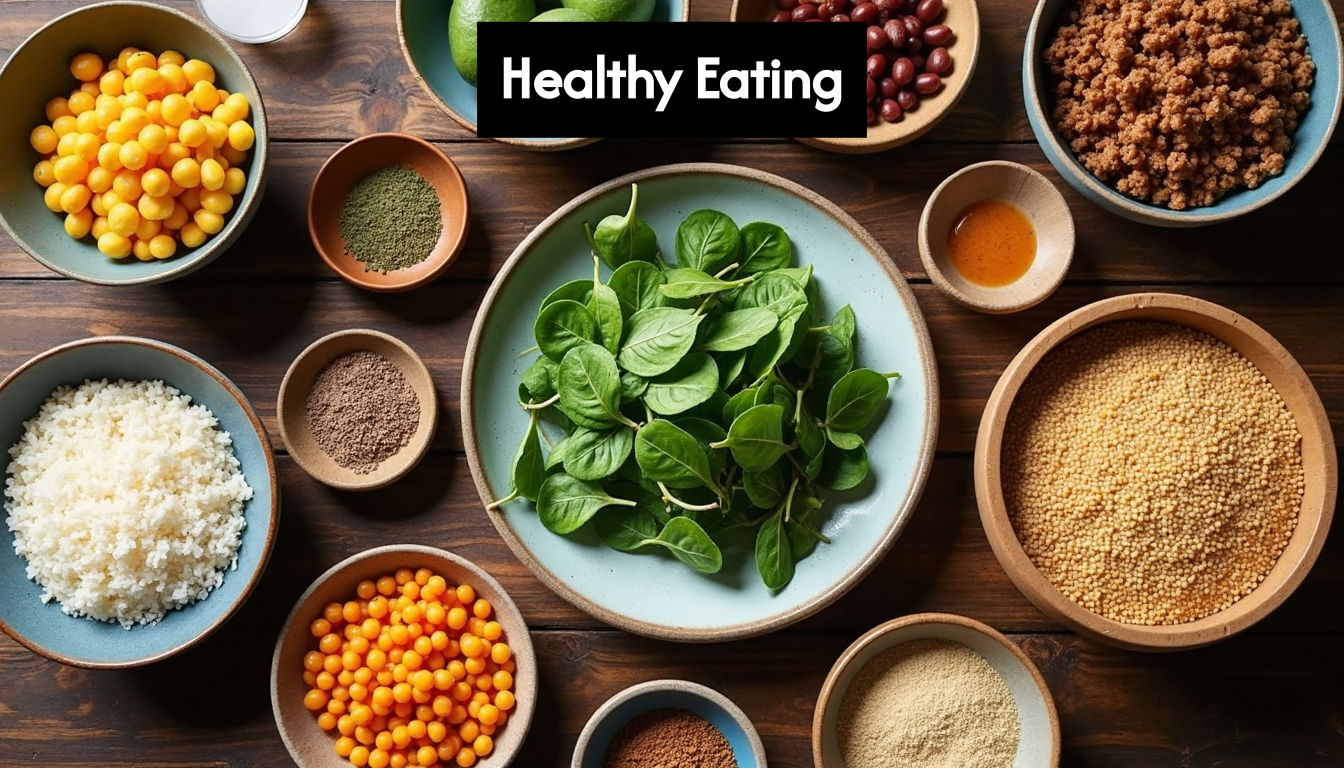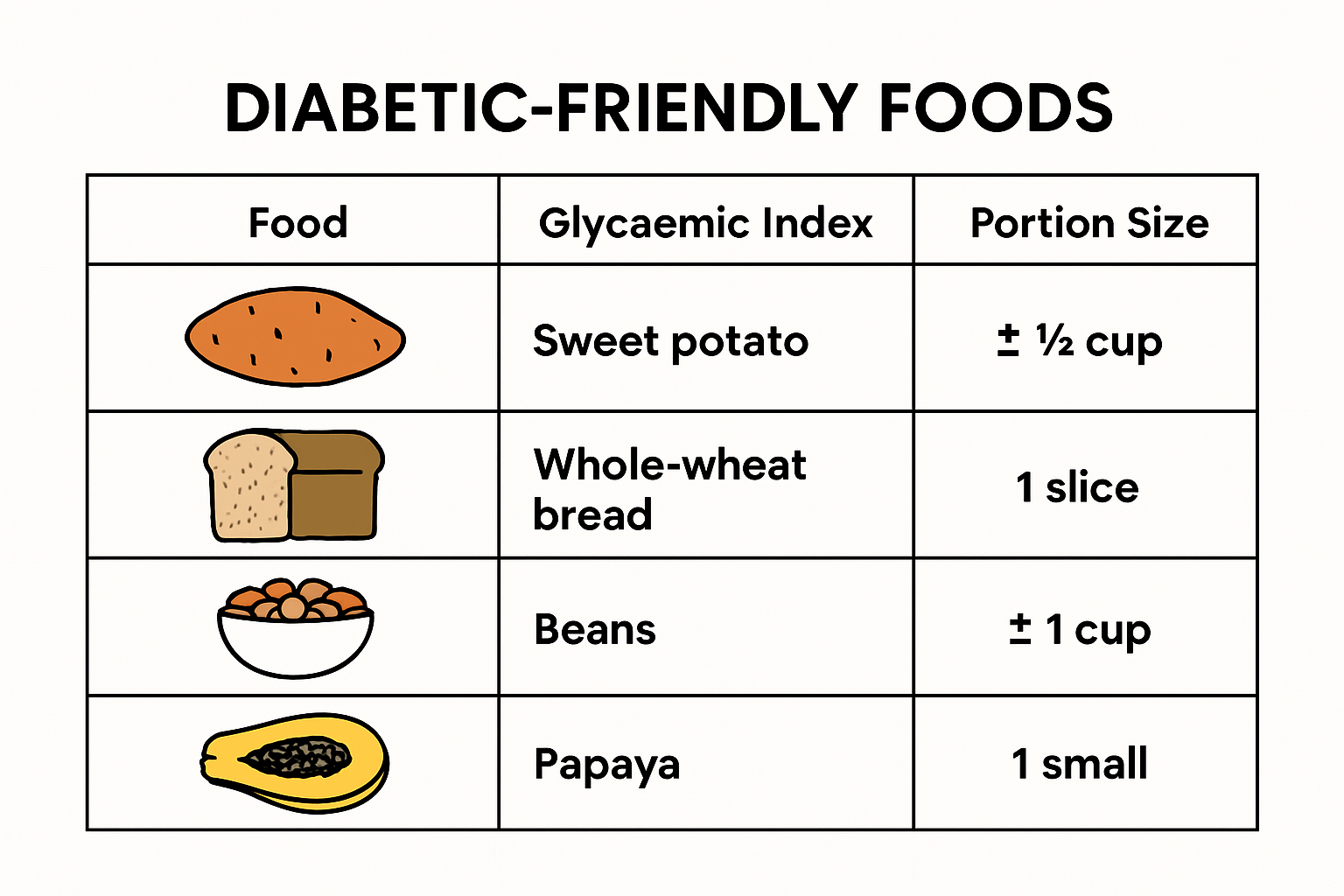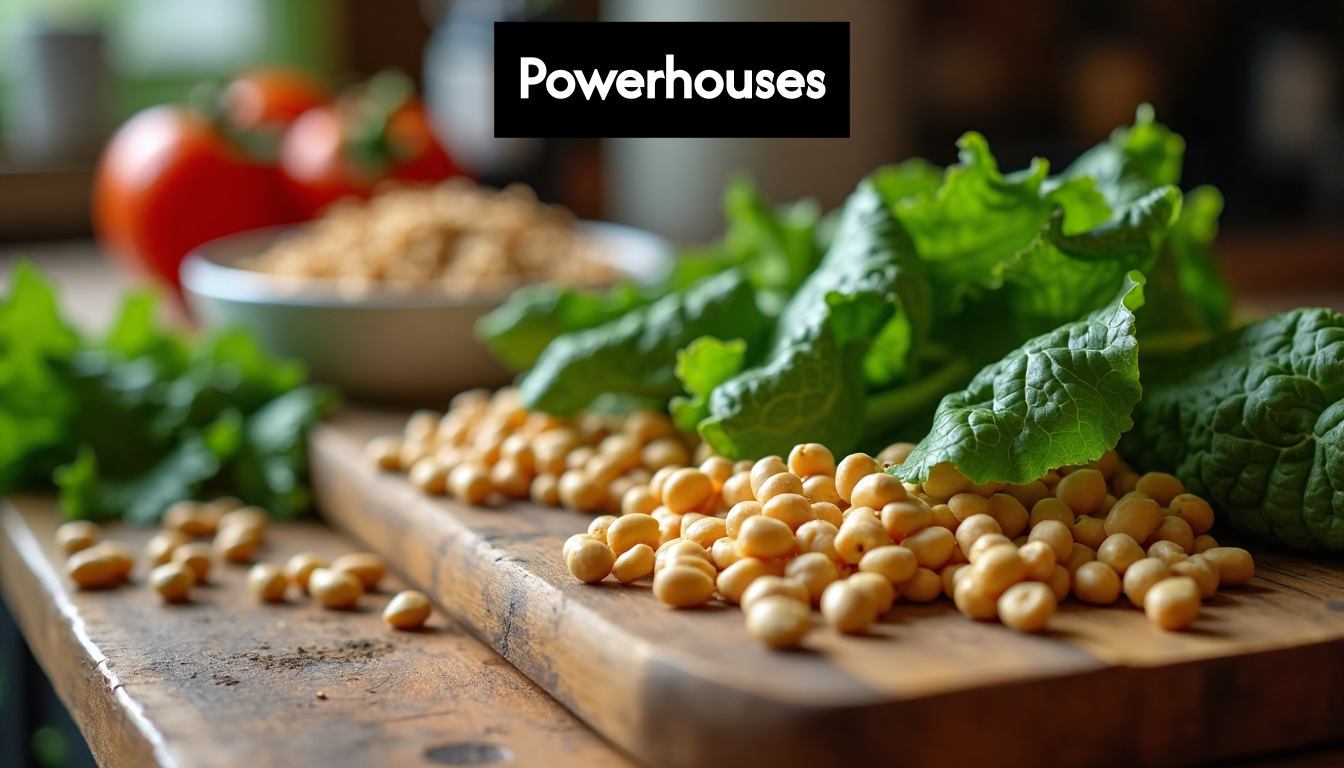
Diabetic-friendly food in South Africa is anything but bland. In fact, the traditional diet brings a colourful mix of options that do more than just fill your plate. Get this: eating local staples like amaranth leaves, wild spinach, and sugar beans can help keep glucose levels steady thanks to their low glycemic index and high fibre. That sounds expected, right? Here is the twist. While sugary drinks and white bread top the list to avoid, smart swaps using ancient grains and whole foods now give South Africans a way to enjoy their favourite meals without the sugar spikes. With over 70 percent of South African adults reporting limited access to healthy foods, these simple changes stand out even more. Want to know which foods make that list and how your next meal could help manage diabetes? The answers might surprise you.
Table of Contents
- Best SA Diabetic Friendly Foods To Enjoy
- Foods To Limit Or Avoid For Diabetes
- Smart Food Swaps And Local Alternatives
- Tips For Healthy Shopping And Meal Prep
Quick Summary
| Takeaway | Explanation |
|---|---|
| Incorporate Low Glycemic Foods | Focus on traditional South African foods like amaranth leaves, legumes, and wild spinach that help regulate blood sugar levels due to their low glycemic index and high fiber content. |
| Limit Refined Carbs and Sugars | Avoid foods like white bread, sugary drinks, and processed baked goods that can lead to rapid glucose spikes and undermine blood sugar control. |
| Emphasize Healthy Fats | Integrate sources of healthy fats such as olive oil, avocados, and nuts to improve metabolic health and support stable blood sugar levels. |
| Opt for Whole Grains | Substitute refined grains with whole grains like brown rice and quinoa for better fiber content and slower glucose absorption. |
| Strategize on Shopping and Meal Prep | Implement techniques like perimeter shopping for fresh produce and using the Diabetes Plate Method for balanced meal planning to enhance healthy eating habits. |

Best SA Diabetic Friendly Foods to Enjoy
Managing diabetes through diet requires strategic food choices that support blood sugar control while delivering essential nutrients. South African cuisine offers a remarkable array of naturally diabetic-friendly foods that can transform how individuals approach healthy eating.
Traditional Low Glycemic Powerhouses
South African traditional foods provide an exceptional foundation for diabetic-friendly nutrition. Amaranth leaves (morogo/imifino) and wild spinach stand out as nutritional champions, offering remarkable benefits for blood sugar management. According to Eating Plant Based ZA, these indigenous greens are naturally low in glycemic index and rich in resistant starch, making them ideal for individuals monitoring their blood sugar levels.
Additionally, protein-rich legumes like sugar beans, Bambara groundnuts, and cowpeas play a crucial role in stabilizing glucose levels. These indigenous ingredients not only provide sustained energy but also contribute significant fiber and micronutrients that support overall metabolic health. Their slow digestion rate helps prevent rapid blood sugar spikes, making them an intelligent dietary choice for diabetic management.

Strategic Healthy Fat Integration
Healthy fats are instrumental in creating balanced meals that support blood sugar regulation. According to nutritional guidance from Unlock Food, incorporating specific fat sources can dramatically improve metabolic health for individuals with diabetes.
Key fat sources recommended include:
- Vegetable oils: Olive, canola, and sunflower oils
- Nuts and seeds: Providing essential omega fatty acids
- Avocado: A nutrient-dense source of monounsaturated fats
- Fatty fish: Such as salmon, offering heart-protective omega-3 compounds
These fat sources not only support stable blood sugar levels but also contribute to cardiovascular health, which is particularly important for diabetic individuals.
Practical Dietary Guidance
For comprehensive and locally tailored nutritional strategies, the Diabetes South Africa Local Flavours Recipe Book offers invaluable resources. This collection provides practical recipes and meal planning approaches specifically designed for South African dietary preferences while maintaining strict blood sugar management principles.
Key recommendations include focusing on whole, minimally processed foods, maintaining portion control, and creating balanced meals that combine lean proteins, complex carbohydrates, and healthy fats. By prioritizing nutrient-dense, low glycemic index foods and understanding how different ingredients interact metabolically, individuals can craft meals that are both delicious and diabetes-friendly.
Navigating diabetes through diet requires thoughtful, informed choices. South African cuisine offers a wealth of naturally supportive ingredients that can transform nutritional approaches, proving that managing blood sugar doesn’t mean sacrificing flavor or cultural culinary traditions.
Foods to Limit or Avoid for Diabetes
While understanding beneficial foods is crucial, equally important is recognizing which dietary choices can potentially compromise blood sugar management and overall health for individuals with diabetes. Making informed decisions about food consumption can significantly impact metabolic control and long-term wellness.
Refined Carbohydrates and Sugar Traps
Refined carbohydrates represent a significant risk for individuals managing diabetes. According to Medical News Today, these foods are quickly converted into glucose, causing rapid and potentially dangerous blood sugar spikes. Key items to limit or avoid include:
- White bread: Rapidly absorbed with minimal nutritional value
- White pasta: High glycemic index causing swift glucose elevation
- Processed baked goods: Often containing hidden sugars and refined flours
- Sugary beverages: Including soft drinks, fruit juices, and sweetened teas
These foods lack essential nutrients and fiber, making them particularly problematic for blood sugar regulation. Their swift conversion to glucose can overwhelm the body’s insulin response, leading to potential metabolic complications.
High-Fat and Processed Protein Sources
Mayo Clinic emphasizes the importance of limiting saturated fats, which can increase cardiovascular risk already elevated in diabetic individuals. Specific protein sources to minimize include:
- High-fat dairy products: Butter and full-fat milk
- Processed meats: Sausages, bacon, and hot dogs
- Fatty cuts of beef: Particularly those with visible marbling
These protein sources not only contribute to potential weight gain but also increase inflammation and cardiovascular disease risk. Choosing lean proteins and plant-based alternatives can provide essential nutrients without compromising metabolic health.
Fried and Fast Foods
Research from the National Center for Biotechnology Information highlights the detrimental effects of fried and fast foods for diabetic individuals. These food categories are particularly problematic due to:
- High trans and saturated fat content
- Excessive caloric density
- Minimal nutritional value
- Potential to accelerate weight gain
Fried foods like french fries, fried chicken, and fast food meals can rapidly destabilize blood sugar levels and contribute to insulin resistance. Their low nutrient profile combined with high inflammatory potential makes them especially dangerous for individuals managing diabetes.
Successful diabetes management requires a holistic approach to nutrition. By consciously avoiding these problematic food categories and focusing on whole, nutrient-dense alternatives, individuals can create a sustainable dietary strategy that supports metabolic health and overall well-being.
Smart Food Swaps and Local Alternatives
Managing diabetes doesn’t mean sacrificing flavor or enjoyment of food. Strategic food swaps can transform traditional meals into nutritionally balanced options that support blood sugar control while preserving the essence of South African culinary traditions.
Grain and Carbohydrate Alternatives
Replacing refined grains with whole grain alternatives offers a powerful approach to diabetes management. According to Bupa’s Health Insights, wholegrain varieties significantly improve nutritional profiles and glycemic control. Smart local swaps include:
- Brown rice instead of white rice
- Quinoa as a nutrient-dense grain alternative
- Whole wheat bread replacing refined white bread
- Sorghum and millet as traditional, low-glycemic grain options
These alternatives provide increased fiber, slower glucose absorption, and more sustained energy release. Indigenous grains like sorghum and millet are particularly valuable, offering cultural relevance alongside exceptional nutritional benefits.
Fruit and Beverage Transformations
Beverage and fruit choices play a crucial role in blood sugar management. Bupa’s Diabetes Nutrition Guide recommends replacing fruit juices with whole fruits to maximize nutritional intake and minimize rapid glucose spikes. Recommended swaps include:
- Whole berries instead of berry juice
- Fresh apples replacing apple juice
- Whole oranges over orange juice
- Unsweetened herbal teas substituting sugary drinks
Whole fruits provide essential fiber that slows sugar absorption, creating a more stable metabolic response. This approach maintains nutritional benefits while supporting blood sugar regulation.
Innovative Diabetic-Friendly Products
Future Market Insights highlights a growing global trend of innovative diabetic-friendly food products. This market evolution offers exciting alternatives for individuals managing diabetes, including:
- Zero-sugar beverages
- High-fiber breads and cereals
- Nutritionally balanced snack options
- Low-carbohydrate meal replacements
These products represent a sophisticated approach to diabetes nutrition, combining scientific research with culinary innovation. They provide convenient, tasty alternatives that support metabolic health without compromising flavor or satisfaction.
Successful diabetes management is about making informed, strategic choices. By embracing these smart food swaps and local alternatives, individuals can create a nutritional approach that is both health-conscious and deeply satisfying. The key lies in understanding how different foods interact with our metabolism and making deliberate, enjoyable choices that support overall well-being.
Tips for Healthy Shopping and Meal Prep
Navigating grocery stores and planning meals can be challenging for individuals managing diabetes. Strategic approaches to shopping and meal preparation can transform nutrition management from a daunting task into an empowering health strategy.
Strategic Shopping Techniques
Mayo Clinic provides critical guidance for diabetic-friendly shopping. Reading food labels carefully becomes a fundamental skill for making informed nutritional choices. Key strategies include:
- Perimeter shopping: Focus on fresh produce, lean proteins, and dairy sections
- Avoid processed food aisles: Minimize exposure to high-sugar and refined products
- Compare nutrition labels: Look for low sugar, high fiber options
- Purchase whole foods: Prioritize minimally processed ingredients
Careful label reading helps identify hidden sugars, unnecessary additives, and nutritional content that might impact blood glucose levels. This approach transforms shopping from a routine task to a proactive health management strategy.
Meal Planning and Preparation Techniques
According to the American Diabetes Association, the Diabetes Plate Method offers a simple yet effective meal planning approach. This method involves:
- Half plate: Non-starchy vegetables
- Quarter plate: Lean proteins
- Quarter plate: Whole grains or starchy vegetables
This visual method simplifies portion control and ensures balanced, nutrient-dense meals. Preparing meals in advance from Ben Fo Complete recommends stocking pantry essentials like whole grains, lean proteins, and healthy fats to prevent impulsive unhealthy choices.
Flavor and Nutrition Optimization
Enhancing meals without compromising nutritional integrity requires creativity. Smart techniques include:
- Herb and spice exploration: Add flavor without salt or sugar
- Batch cooking: Prepare multiple meals simultaneously
- Portion control containers: Manage serving sizes effectively
- Freezing prepared meals: Create convenient, healthy options
Experimenting with herbs like thyme, rosemary, and local South African spices can transform simple ingredients into delicious, diabetes-friendly meals. The goal is creating sustainable, enjoyable eating habits that support metabolic health.
Successful diabetes management isn’t about restriction but intelligent, informed choices. By implementing these shopping and meal preparation strategies, individuals can develop a personalized nutrition approach that feels empowering, delicious, and supportive of overall wellness.
Frequently Asked Questions
What are some diabetic-friendly foods available in South Africa?
Eating diabetic-friendly foods in South Africa includes traditional staples like amaranth leaves, wild spinach, sugar beans, and healthy fats like avocado and nuts. These foods are naturally low in glycemic index and high in fiber, making them ideal for blood sugar management.
How can I swap refined carbs for healthier alternatives?
To swap refined carbs for healthier choices, consider replacing white rice with brown rice, white bread with whole wheat bread, and pasta with quinoa. These alternatives provide better fiber content and slower glucose absorption, aiding in blood sugar control.
What foods should be avoided for better diabetes management?
For better diabetes management, it’s essential to avoid refined carbohydrates such as white bread and sugary beverages, as well as high-fat processed meats and fried foods, which can cause rapid blood sugar spikes and increase cardiovascular risks.
What shopping tips can help in managing diabetes?
When shopping, focus on perimeter areas of the store for fresh produce, lean proteins, and dairy. Avoid processed food aisles, read food labels carefully for sugars and additives, and prioritize whole foods to ensure better blood sugar control.
Sweeten Your Diabetic-Friendly Lifestyle the Natural Way
Are you frustrated by the struggle to enjoy South African favourites while watching your sugar intake? If you are tired of seeing high-sugar options and missing out on the tastes you love, you are not alone. This article highlights fresh solutions like low glycemic foods and healthy swaps, but making your meals diabetic-friendly can still feel challenging when it comes to sweet treats.

Give yourself the freedom to indulge—safely and deliciously. Allulo.co.za empowers you to transform everyday recipes with organic Allulose, a natural sweetener that looks and tastes like sugar but has almost zero impact on blood glucose. Whether you are baking, sweetening your morning oats or looking for diabetic-approved dessert recipes, Allulose opens up a world of flavour and joy without the worry. Visit Allulo.co.za today and discover the difference. Your happy, healthier plate can start now.

